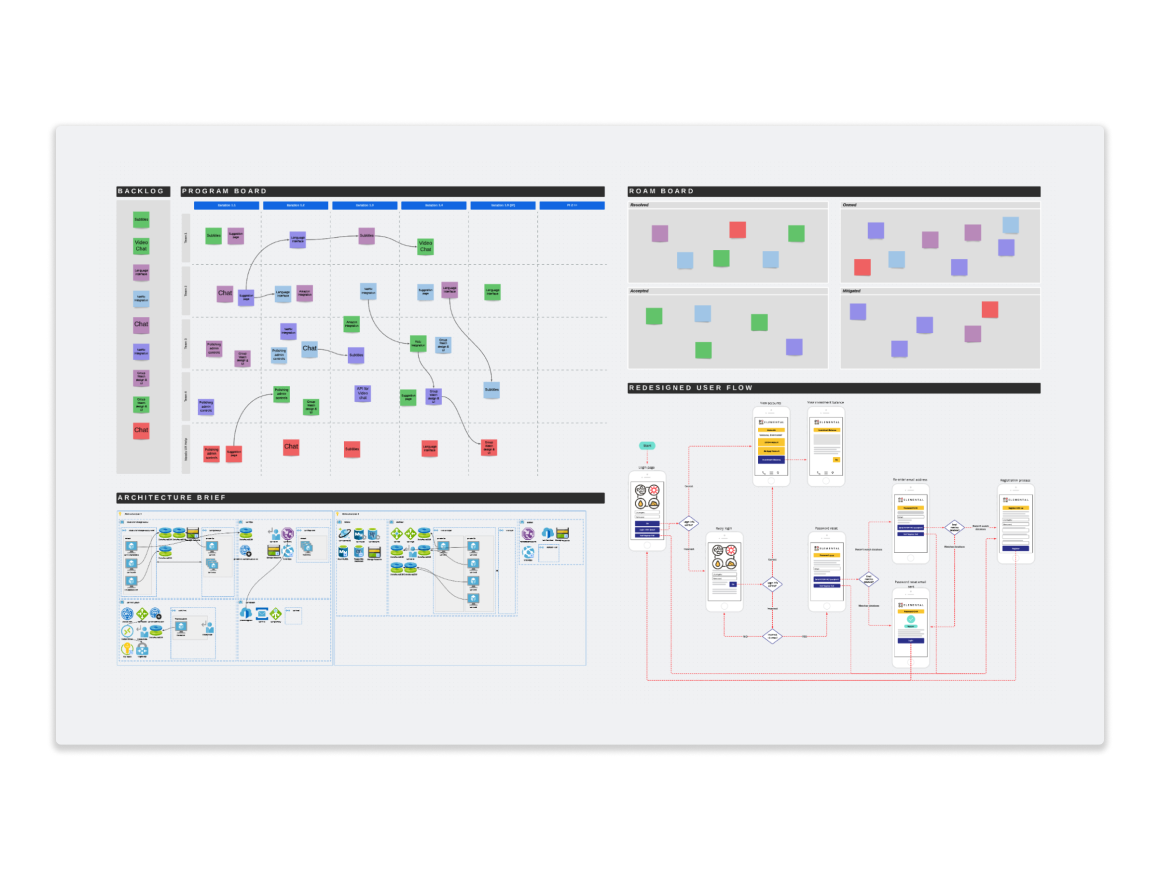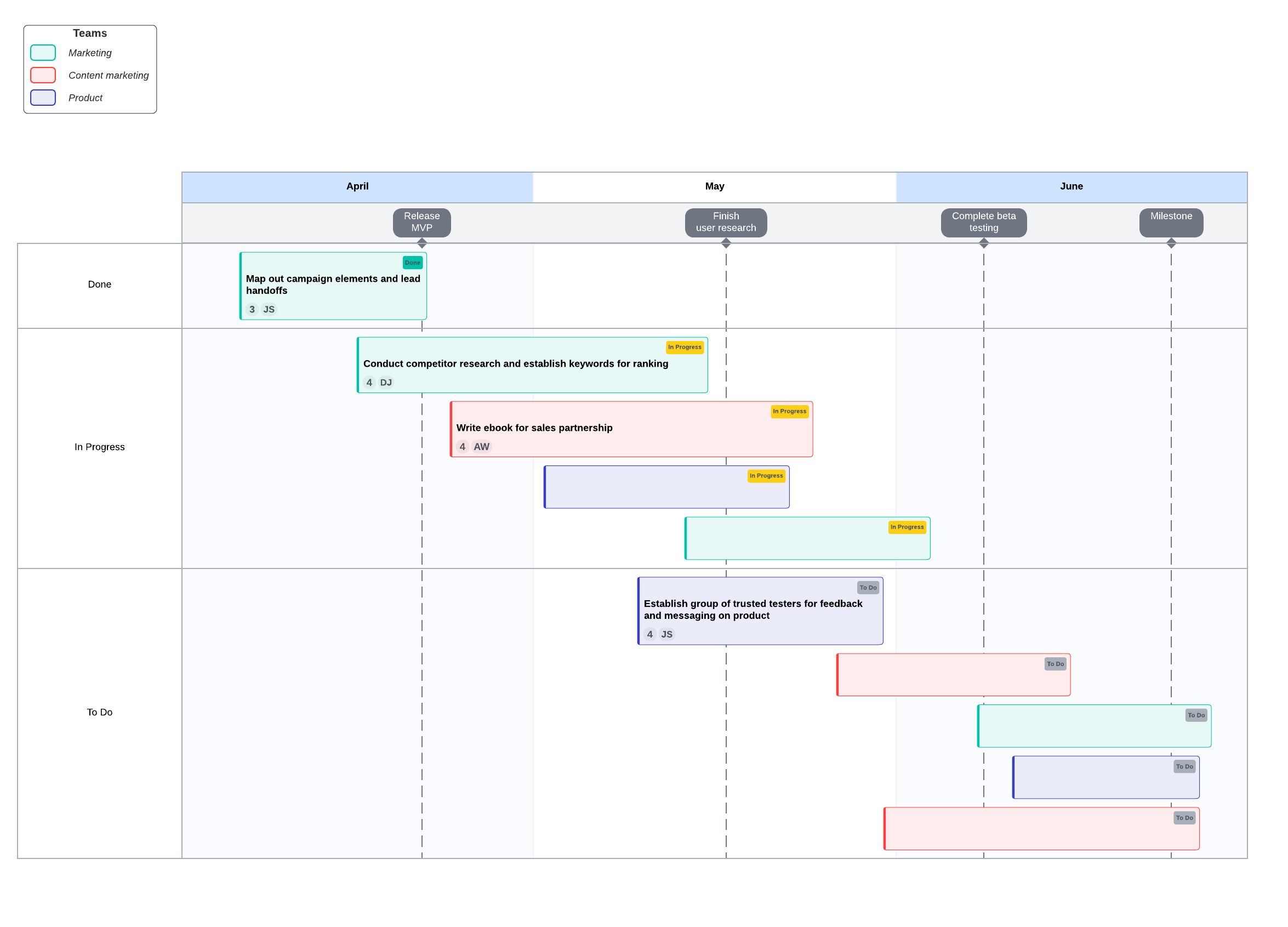
3 ways Lucid accelerates innovation for R&D teams
Reading time: about 8 min
Innovation. This word is echoing in the ears of every technical team member. Companies are making it their mission to stand on the cutting edge of their industries, and research and development (R&D) teams are tasked with getting them there.
But the path to innovation isn’t always clear, especially when collaboration is complex. To drive results and accelerate innovation, R&D teams need powerful solutions to visually communicate their ideas, gain stakeholder buy-in, and streamline the development process.
The Lucid Visual Collaboration Platform can take your projects from ideation to execution. On average, Lucid users save 2.4 hours per week when it comes to the development and launch of new products. That’s why 68% of users say Lucid is critical for their job performance. When you can actively visualize complex systems, build a single source of truth, and stay aligned from idea to reality, there’s no barrier to innovation.
In this article, we’ll dive into three ways Lucid removes barriers between R&D teams and innovation.
1. Add focus to product planning
At Lucid, we know first-hand that creating a stellar product requires thorough preparation, clear communication, and plenty of cross-departmental collaboration.
R&D teams need to be able to capture ideas, research, and plans easily and distribute them widely. Communication between teams can be a severe bottleneck for innovation—but it doesn’t have to be.
With Lucid, you can easily work together across time zones, departments, and schedules. Our platform provides a visually collaborative space to gather data, ideate solutions, document plans, and align stakeholders. Focus your product planning in Lucid by:
Centralizing product requirement information
Compiling product requirements from other departments in your organization, or from your customers, is a critical step to gaining alignment in the planning process.
With Lucid, you can easily capture the information you need—and share it with stakeholders—in one central space. Gather product requirement feedback, stakeholder requests, and other important input using Lucid's collaborative features and integrations.
Lucid makes commenting, prioritizing, and collaborating on requirements in real-time or asynchronously straightforward.


Join Lucid's Community
Get inspired, share ideas, ask questions, and connect with other professionals in your field.
Join nowVisualizing the release timeline
Planning a product release means assembling many moving parts into a coherent picture. Your R&D team might need to provide a high-level overview of the release plan to collaborators to ensure everyone stays on the same page and the project stays on track.
Use Lucid to visualize the timeline of your release and instantly make the entire project feel more manageable and make executing key tasks easier.
Collaborating in hybrid work environments
Hybrid work provides countless benefits for teams all over the world, but one of the downsides for R&D teams is the lack of big-room collaboration. When you need to get everyone involved in a project together to work on a single vision, Lucid can help. Use Lucid to bring people together on a shared canvas from anywhere in the world, whether you’re working with tons of collaborators or on a more agile team.

Integrating with existing workflows
R&D teams need a platform that can accommodate and improve existing workflows, not get in the way. Lucid seamlessly integrates with systems like Jira or Azure DevOps to stay aligned on product backlog items. No need to worry about things slipping through the cracks—there’s two-way sync to ensure both systems stay up-to-date.
Aligning on the user experience
Lastly, you can leverage Lucid’s advanced diagramming capabilities to understand the user experience using journey maps, personas, and interaction flows. These artifacts act as living documents that are easily shared, collaborated on, and updated, making them valuable resources throughout the entire product development process.

How DocuSign uses Lucid
You don’t have to take our word for it. See how DocuSign uses Lucid to improve the product planning process.
Read how2. Visualize data and architecture design
Data and architecture design are at the heart of R&D teams' daily responsibilities. Because these teams work with incredibly complex systems, visualization makes it easier to understand the tangled relationships between components.
Lucid propels project timelines forward by helping teams reach a shared understanding quickly. By creating a visual blueprint of a system, its components, and relationships, you can drive clarity and comprehension across teams and departments.
Create valuable documentation and visualize your data and architecture design by:
Designing architectural diagrams
Using Lucidchart to create your software architecture diagrams helps increase understanding, communication, and collaboration across teams. Whether you’re creating diagrams for the current state, ideal future state, or even proposed architecture, Lucidchart can speed up the process with templates and pre-built shape libraries.
In addition, Lucid offers the ability to create custom shape libraries for consistent documentation. You can add custom shape data to display details like IP addresses, memory size, subnets, and gateways.
Automating diagram creation
To take diagramming even further, Lucid can automatically generate cloud diagrams when integrated with a cloud provider like AWS, Azure, or Google Cloud (using Lucidscale). Using this feature, you can instantly visualize your cloud infrastructure and use this documentation to keep everyone on the same page.
Sharing with stakeholders
Lucid facilitates easy sharing with collaborative features that help leadership, other architects, or even non-technical team members understand the vision. Any team member can leave feedback or questions directly on the diagram, making asynchronous collaboration a breeze.

Teams can leverage these diagrams for compliance processes, like architecture reviews, to spot gaps or issues by comparing them to standards. Best of all, your creations in Lucid act as living documentation that can be referenced repeatedly. This modern and refreshing approach to documentation keeps everyone aligned and engaged.

Check out our full library of architecture templates to see what’s possible to create.
Check it out3. Simplify cloud migration
Migrating years of outdated code and architecture is a top priority for R&D teams. But cloud migration projects are tremendous undertakings with many moving components to manage on top of ambitious deadlines.
In order to migrate to the cloud securely and efficiently, teams need a way to visualize the supporting infrastructure, identify critical gaps or hurdles, and make informed decisions. Lucid supports R&D teams and other collaborators through the intricate cloud migration process. Streamline cloud migration by using Lucid for:
Prioritizing initiatives and planning timelines
Lucid’s virtual whiteboard lets you connect with team members and prioritize which applications and services to migrate.
To successfully execute a cloud migration, R&D teams have to work together to map out the project timeline in significant detail. Lucid’s integrations with systems like Jira can help you stay on top of projects, even as needs change.

Visualizing the infrastructure to validate deployments
Lucid’s pre-built templates, expansive shape libraries, and automated diagram generation capabilities, help make cloud migration projects faster, easier, and more accurate.
You can map out the current state of your infrastructure and your ideal state in the cloud using Lucidchart. Then, simply share these documents with stakeholders to accelerate design approvals.
Once you’ve migrated to the cloud, you can return to the drawing board and verify that your new current state aligns with approved designs. Lucidscale accelerates the process by automatically generating cloud diagrams. Use these diagrams to validate architecture deployment, reduce risk, and mitigate unnecessary costs.
Creating a single source of truth
By using Lucid to document priorities, migration plans, and cloud architecture, teams naturally create a single source of truth (SSOT) for all project details. An SSOT means more agile teams, less duplicate work, more effective team training, and easier scaling capabilities. Lucid also helps you add quick, up-to-date visuals to your central information hub, making it easy to troubleshoot issues.

The value of an end-to-end visual collaboration platform
R&D teams need a robust, agile visual collaboration solution to fuel their workflows. Lucid is the only visual collaboration platform to support the entire software and product development lifecycle—from ideation to planning, designing, building, and launching.
While simple digital whiteboarding tools help teams collaborate and ideate, they often fail to address the entire workflow, leaving teams with disjointed experiences, scattered information, and no clear way to bring their ideas to life.
We have three products in our arsenal to help you tackle your entire R&D workflow:
- Lucidspark is our virtual whiteboard that powers ideation, prioritization, and product planning.
- Lucidchart is our flagship diagramming product, perfect for designing your software architecture and mapping your data.
- Lucidscale automates the cloud visualization process so teams can easily understand and optimize their architecture.
By leveraging these three products, R&D teams can tackle even the most complex projects. When organizations use Lucid to collaborate across the entire R&D lifecycle, the business benefits in a few critical ways:
- Consolidated tools. Lucid can replace multiple point solutions, allowing you to streamline your workflow, increase efficiency, and consolidate your tools. In fact, a commissioned study conducted by Forrester Consulting on behalf of Lucid found that a composite organization using Lucid was able to cut costs by 32% by streamlining its tech stack. (The Total Economic Impact™ Of The Lucid Visual Collaboration Suite, May 2023)
- Time savings. Creating visuals in a collaborative setting means getting everyone on the same page faster and easier. Forrester Consulting also found that a composite organization saved 344,000 hours in user efficiencies with the Lucid Suite.
- Reduced costs. Visual collaboration can help clarify complex projects and systems and reduce costs associated with expensive mistakes. Lucid also helps reduce costs by saving you time and consolidating tools—$4.1M in user efficiencies, according to Forrester’s recent study
- Accelerated growth. All the ideas, plans, and technical documents needed to accelerate innovation stay in Lucid as a living blueprint of your business. Forrester Consulting found that a composite organization using Lucid saved 692,000 hours over the span of three years.

Get in touch
We’re ready to help your R&D teams accelerate innovation with Lucid.
Contact us todayAbout Lucid
Lucid Software is the leader in visual collaboration and work acceleration, helping teams see and build the future by turning ideas into reality. Its products include the Lucid Visual Collaboration Suite (Lucidchart and Lucidspark) and airfocus. The Lucid Visual Collaboration Suite, combined with powerful accelerators for business agility, cloud, and process transformation, empowers organizations to streamline work, foster alignment, and drive business transformation at scale. airfocus, an AI-powered product management and roadmapping platform, extends these capabilities by helping teams prioritize work, define product strategy, and align execution with business goals. The most used work acceleration platform by the Fortune 500, Lucid's solutions are trusted by more than 100 million users across enterprises worldwide, including Google, GE, and NBC Universal. Lucid partners with leaders such as Google, Atlassian, and Microsoft, and has received numerous awards for its products, growth, and workplace culture.
Related articles
Level up your cloud migration strategy with Lucid
In this blog post, we will explore how to level up your cloud migration strategy with Lucid.
How Lucid’s IT teams use Lucid to solve complex problems
Our IT teams use Lucid to clarify complex data and streamline their workflows. Learn more about their processes here.
5 ways engineering teams can streamline project documentation with Lucid
Get insider tips on using Lucid for project documentation from Lucid’s senior director of engineering.
Process improvement toolkit for R&D teams
This article includes tips and templates for process improvement at all stages of product development, from ideation to launch.
